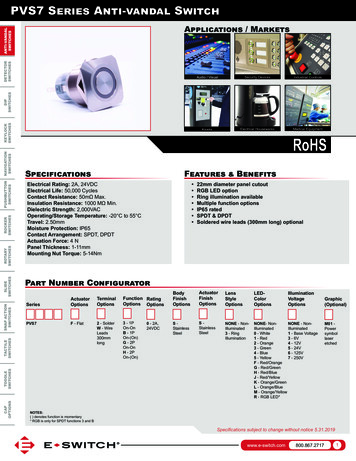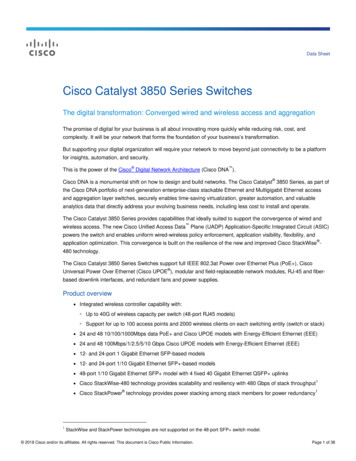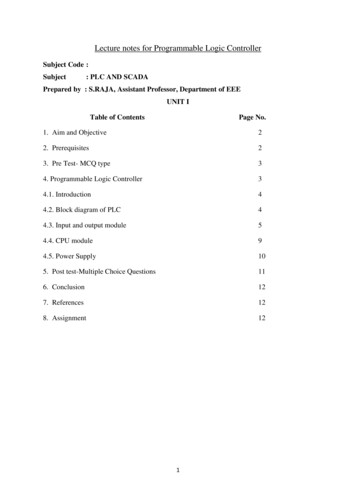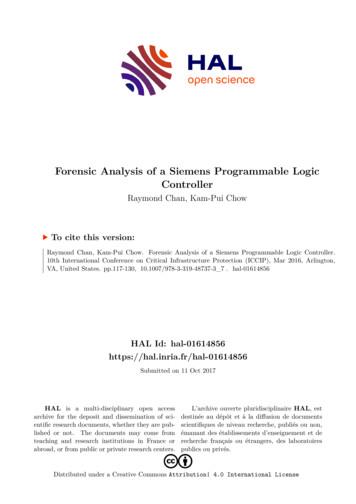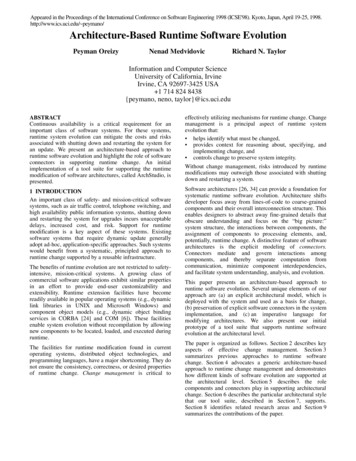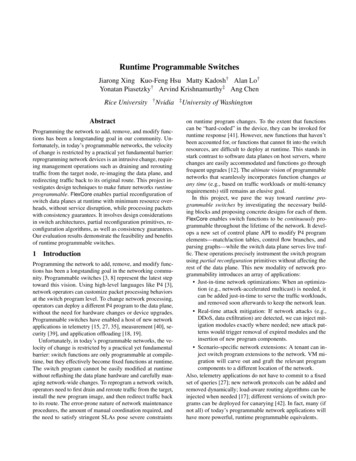
Transcription
Runtime Programmable SwitchesJiarong Xing Kuo-Feng Hsu Matty Kadosh† Alan Lo†Yonatan Piasetzky† Arvind Krishnamurthy‡ Ang ChenRice University† Nvidia ‡ UniversityAbstractProgramming the network to add, remove, and modify functions has been a longstanding goal in our community. Unfortunately, in today’s programmable networks, the velocityof change is restricted by a practical yet fundamental barrier:reprogramming network devices is an intrusive change, requiring management operations such as draining and reroutingtraffic from the target node, re-imaging the data plane, andredirecting traffic back to its original route. This project investigates design techniques to make future networks runtimeprogrammable. FlexCore enables partial reconfiguration ofswitch data planes at runtime with minimum resource overheads, without service disruption, while processing packetswith consistency guarantees. It involves design considerationsin switch architectures, partial reconfiguration primitives, reconfiguration algorithms, as well as consistency guarantees.Our evaluation results demonstrate the feasibility and benefitsof runtime programmable switches.1IntroductionProgramming the network to add, remove, and modify functions has been a longstanding goal in the networking community. Programmable switches [3, 8] represent the latest steptoward this vision. Using high-level languages like P4 [3],network operators can customize packet processing behaviorsat the switch program level. To change network processing,operators can deploy a different P4 program to the data plane,without the need for hardware changes or device upgrades.Programmable switches have enabled a host of new networkapplications in telemetry [15, 27, 35], measurement [40], security [39], and application offloading [18, 19].Unfortunately, in today’s programmable networks, the velocity of change is restricted by a practical yet fundamentalbarrier: switch functions are only programmable at compiletime, but they effectively become fixed functions at runtime.The switch program cannot be easily modified at runtimewithout reflashing the data plane hardware and carefully managing network-wide changes. To reprogram a network switch,operators need to first drain and reroute traffic from the target,install the new program image, and then redirect traffic backto its route. The error-prone nature of network maintenanceprocedures, the amount of manual coordination required, andthe need to satisfy stringent SLAs pose severe constraintsof Washingtonon runtime program changes. To the extent that functionscan be “hard-coded” in the device, they can be invoked forruntime response [41]. However, new functions that haven’tbeen accounted for, or functions that cannot fit into the switchresources, are difficult to deploy at runtime. This stands instark contrast to software data planes on host servers, wherechanges are easily accommodated and functions go throughfrequent upgrades [12]. The ultimate vision of programmablenetworks that seamlessly incorporates function changes atany time (e.g., based on traffic workloads or multi-tenancyrequirements) still remains an elusive goal.In this project, we pave the way toward runtime programmable switches by investigating the necessary building blocks and proposing concrete designs for each of them.FlexCore enables switch functions to be continuously programmable throughout the lifetime of the network. It develops a new set of control plane API to modify P4 programelements—match/action tables, control flow branches, andparsing graphs—while the switch data plane serves live traffic. These operations precisely instrument the switch programusing partial reconfiguration primitives without affecting therest of the data plane. This new modality of network programmability introduces an array of applications: Just-in-time network optimizations: When an optimization (e.g., network-accelerated multicast) is needed, itcan be added just-in-time to serve the traffic workloads,and removed soon afterwards to keep the network lean. Real-time attack mitigation: If network attacks (e.g.,DDoS, data exfiltration) are detected, we can inject mitigation modules exactly where needed; new attack patterns would trigger removal of expired modules and theinsertion of new program components. Scenario-specific network extensions: A tenant can inject switch program extensions to the network. VM migration will carve out and graft the relevant programcomponents to a different location of the network.Also, telemetry applications do not have to commit to a fixedset of queries [27]; new network protocols can be added andremoved dynamically; load-aware routing algorithms can beinjected when needed [17]; different versions of switch programs can be deployed for canarying [42]. In fact, many (ifnot all) of today’s programmable network applications willhave more powerful, runtime programmable equivalents.
Achieving this goal requires a range of research challengesto be addressed: switch architecture designs that make runtimeprogrammability natural, partial reconfiguration primitives formodifying live switch programs, atomicity and consistencyguarantees on runtime changes, and algorithms for effectivelycomputing reconfiguration plans. FlexCore makes contributions in all these dimensions.Switch architecture. We base our FlexCore design upona variant of disaggregated RMT (dRMT) [11]. dRMT separates switch memory from compute, and our architectureintroduces another twist in its partial disaggregation design,where a small compute-local memory holds a indirection datastructure that we call a program description table (PDT). Thistable contains metadata about the program control flow and isour target for reconfiguration. Decoupling program logic fromits physical realization separates concerns: physical resourcescan be allocated and deallocated in scratch areas before program elements are modified for the changes to be visible.Partial reconfiguration primitives. We develop a set ofnew primitives for adding, removing, and modifying program elements—this includes match/action tables, controlflow branches and parser states. Unlike today’s control planeAPI, which manipulates switch memory (e.g., adding/removing entries), the new API reconfigures switch compute.Consistency guarantees. We propose three consistencyguarantees for runtime reconfiguration: program consistency,element consistency, and execution consistency, with increasingly relaxed guarantees. These guarantees constrain the kindof “intermediate programs” that packets are allowed to encounter during partial reconfiguration. Program consistencystates that all program modifications must take effect simultaneously. Element consistency is weaker, and states that modifications can be made visible in an element-by-element basis(e.g., one table at a reconfiguration step). Execution consistency is the weakest, but it still guarantees useful properties:packets never traverse execution paths that mix old and newprogram elements. In all cases, reconfigurations are atomicand do not disrupt data plane forwarding.Algorithms. We develop algorithms for computing reconfiguration plans for different levels of guarantees.Evaluation. We implement our design on a 12.8 Tbps merchant silicon (Nvidia Spectrum-2 SN3000 series), as well asa software simulator based upon bmv2. We evaluate the scalability of the reconfiguration algorithms and demonstrate aset of use cases in hardware and software platforms, showingthat FlexCore enables a truly adaptive network core.2A Case for Runtime ProgrammabilityThe quest for network programmability has been an important undertaking in the community. Network switches used tobe blackboxes, with opacity at both control and data planes.OpenFlow SDN opened up the control plane for programmatical control, and as of late, programmable data planesenable flexible packet processing pipelines without hardwareupgrade. Operators can customize the data plane by removing unnecessary switch functions or adding new ones at theprogram level. P4 switch programs are compiled into a binaryimage, which is flashed to data plane hardware for deployment.Researchers have seized this opportunity to systematicallyrearchitect network telemetry [15, 27, 35], measurement [40],security [39], and application offloading [19].However, today’s programmable data planes have a notablelimitation—they cannot be reprogrammed at runtime. If anoperator can anticipate all required functions at compile time,and if these functions can fit into the switch resource constraints, then they can be combined and deployed together inthe switch. But once deployed, the switch is committed tothe hardcoded behaviors as specified at compile time, untilthe next program reflash. At runtime, only ‘micro’ changesare permitted, such as modifying flow table entries or registervalues from the control plane. This affords some flexibility [41]; however, as macro-level program logic changes arehard to make, accommodating requirements that truly arise‘on-demand’ (e.g., security incidents) remain an elusive goal.Also, since switches have constrained resources, even if wehad an ‘oracle’ planner that anticipates all needed functions,they may not fit into the switch together at compile time.To remedy this problem, we need runtime programmableswitches. This not only enables new use cases as motivatedabove, but also calls for a rethink as to how networks canbe specialized. The operator can, at any point in time, aggressively optimize the network data plane to only retain aminimal amount of processing logic. This reduces switch resource footprints, improves network energy efficiency, andalso keeps network latency at a minimum. If extra functionality is required, the program elements can be injected preciselywhere and when they are needed. If a functionality is nolonger in use, it can be removed to ensure that the data planestays at its leanest. Viewed from the lens of the classic ‘end-toend’ arguments [31], in-network processing no longer incursa common overhead to all applications.3The FlexCore Switch ArchitectureOur switch architecture adopts a disaggregated RMTmodel [11], where compute resources (i.e., match/action processors) are split from memory (i.e., SRAM/TCAM), andthey are interconnected via a crossbar. Each MA processorholds a copy of the P4 program, and processes packets in arun-to-completion manner.In the RMT architecture [8], each stage contains a slice ofcompute and memory resources that cannot be reassigned toother stages. This tight coupling makes runtime reconfigurations challenging. For instance, inserting an MA table to astage may require device-wide table shuffling and reallocationto make space. Removing an MA table from a stage will leave‘holes’—fragmented resources that cannot be easily reused byother program elements. These operations can be intrusive.A disaggregated architecture, on the other hand, breaks
PktDeparserOutProgram description table Action memory⑤Actions, next action pointer①prog desc entry⓪Actions, next action pointer PDTMatch ActionPDTMatchActionPDTActionMA processorsMatch ParserPktInActions, next action pointerprog desc 0 Load-balanced crossbarDisaggregated,sharded access Memory bank 1TCAM region。。。 TCAM region②SRAM region③⑥SRAM region。。。prog desc iMemory bank t ⑦ SRAM regionprog desc nFigure 1: The FlexCore switch architecture. Highlighted inbold italic are the customizations to dRMT [11].resource allocation boundaries and enables reconfigurations tobe performed locally—i.e., it enables partial reconfiguration.If a reconfiguration releases a table, the deallocated resourcescan be dedicated to any other program elements irrespectiveof their ‘locations’. New tables can be inserted to any partof the program without having to change existing resourceallocation decisions. Similar properties hold for resources thatimplement control flow branches and parsing graphs.dRMT customizations. Our silicon also implements several customizations for performance, flexibility, and usability.Figure 1 shows the high-level architecture.(i) Sharded resource allocation. In the dRMT architecture,an MA table is allocated in one specific SRAM/TCAM bank.Simultaneous accesses to the same table (or different tablesin the same memory bank) from different processors createscontention at the crossbar. In FlexCore, all tables are t-waysharded, where t is the number of memory banks. When inserting a table entry, FlexCore first computes a hash h fromthe match key as the shard ID, and then allocates the entry inthe h-th SRAM/TCAM bank. When performing a match, thesame hash function is computed to retrieve the shard ID. Thisallows FlexCore to sustain linerate without complex mechanisms to detect and avoid access contention. The crossbar isalways load-balanced and has uniform access patterns.(ii) Hybrid programmability. Our switch exports a set offixed-function ASIC modules as common building blocks(e.g., L2 bridging, L3 routing). These functions can be calledby or bypassed from the P4-programmable logic. The fixedblocks are more resource- and energy-efficient, as their implementations are heavily-optimized, hardwired ASIC. Byproviding these building blocks, P4 programmers don’t needto redevelop them from scratch. Moreover, they also representa minimum “baseline” program that, if necessary, traffic canalways fallback on during reconfiguration.(iii) Indirection. FlexCore employs a partially disaggregated design, where each processor has a small amount oflocal SRAM to store a special program description table(PDT) for indirection. Accesses to PDT do not go through thecrossbar and enjoy lower latency. PDT stores the ‘programskeleton’—the control flow graph—and decouples the controlflow operations from main SRAM accesses. Our partial recon-Match keyKey typeSRAM ptrTCAM ptrAction ptrNext tab/branch ptr Table1 shardsTable2 shardsTable3 shards④TCAMTCAM region SRAMFigure 2: Runtime reconfigurable tables and control flowbranches, the indirection mechanism via the program description table (PDT), and an example execution as illustration.11figuration mechanisms make heavy use of the PDT to modifyprogram elements. Similarly, a parser state table (PST) servesas indirection for the parsing hardware.4Runtime Reconfiguration PrimitivesFlexCore introduces a set of novel primitives that, when invoked by the control plane, partially reconfigure a P4 switchprogram. These primitives operate on a graph representationof a P4 program by adding, removing, or modifying nodesand edges. In a P4 program, the match/action logic is captured by the ‘table flow graph’ [8], where nodes represent MAtables or conditional branches (realized in table-independentactions), and edges represent non-conditional, table dependency control flow. For the parser logic, the nodes representparser states (which also contain header extraction rules), andthe transition rules are the edges. Next, we first describe theprimitives on the table flow graph and then the parsing graph.4.1Program description tableA key indirection data structure that enables partial reconfiguration of the table flow graph is what we call a programdescription table (PDT), as shown in Figure 2. Each match/action processor maintains a local PDT and it is dedicated to aspecific switch port. All packets arriving at a port will first hita default entry in the PDT to activate packet processing.The entries in the PDT are compiled from a P4 program.Each entry stores metadata about a program element, whichcould be a match/action table or a table-independent ALUaction that implements conditional control flow. The metadatacontains entry type, match key/type, and a resource pointerthat refers to the physical realization of that program element.The pointer address could be an SRAM location (for exact andalgorithmic ternary matches), a TCAM location (for ternarymatches), or an action location (for conditional branches)—with a ‘union’ semantics as only one pointer type can be validfor a PDT entry. The address is specified by the base addressof a memory region, the size of the region, as well as the offsetfrom the base address. Each PDT entry also contains a ‘next’
pointer, which encodes unconditional control flow to the nextprogram element (i.e., MA table or conditional branch).This indirection provides several advantages for runtimeprogrammability: a) operations for adding and removing aprogram element are decoupled from resource allocation operations, as the first occur in the PDT and the second in thememory regions; b) PDT entries serve as a local scratch—entry modifications are lightweight and do not touch switchwide shared resources, and they can be changed in a transactional manner. The PDT enables runtime reconfigurationof match/action tables and the control flow graph, which wediscuss next.4.2Runtime reconfigurable tablesMA tables are the key processing elements in a P4 program.FlexCore enables the addition and deletion of tables usingseveral partial reconfiguration primitives.Allocation deallocation. A LLOC T BL ( T ) allocates a newtable, and D EALLOC T BL ( T ) deallocates an existing one. Bothare control plane operations that have a centralized view ofPDT tables, and they accept the table definition T as the inputargument. Allocations first identify free slots to create newPDT entries. In a new PDT entry, the match key and type arefilled in with the specified table attributes. SRAM and TCAMresources are then allocated based on the table attributes, andboth are sharded across all memory banks. Finally, the controlplane fills in the resource pointer, finishing the table allocation. Deallocations could directly remove the entry and itsresources, or it may defer their removal to a later garbagecollection phase. (Actual table entries are added/removed justlike in today’s switches, via existing control plane API such asthat defined in P4Runtime [5].) Importantly, allocation/deallocation operations are not visible to network traffic until weinvoke insertion/deletion primitives.Insertion deletion. Changes are made visible via anotherprimitive: S ET P TR ( T, NXT ) modifies T’s next pointer to NXT.Table insertions invoke multiple S ET P TR calls to place T inthe program; deletions perform the opposite operations. Insertions must happen after resources have been allocated, anddeletions before deallocation. Each pointer change is atomicin hardware. (To ensure atomicity for a collection of changes,we need another mechanism called a ‘flex branch’ as discussed later.) Insertions and deletions alter the view of theprogram state from the perspective of network traffic.4.3Runtime reconfigurable control flowConditional branches are implemented in ALUs as tableindependent actions. Like tables, a conditional branch takesup one PDT entry, but its resource pointer addresses the action memory instead of SRAM/TCAM. In addition, the PDTentry for a conditional branch has a null ‘next’ pointer; itstwo jump addresses are instead encoded in the ALU action,one for each branch condition. N-way conditionals are implemented as cascading binary branches. Control flow branchPDTprog desc entryTable tDeletedActivea 1, b 1, act act1, priority 1a 2, b 2, act act1, priority 1a 3, b 3, act act2, priority 1a 4, b 4, act act2, priority 1Tablegroupprog desc iprog desc j act2a 5, b 5, act act1, priority 1 Table t’Actionresolveract3a 1, b 1, c 1, act act3, priority 2a 2, b 2, c 1, act act3, priority 2act3a 3, b 3, c 2, act act3, priority 2Figure 3: Primitives for in-place table modification.modifications are performed using the following primitives.Allocation deallocation. FlexCore introduces a primitive,A LLOC C OND ( B , PRED , BR1 , BR2 ), to allocate a control flowbranch based on PRED, where BR1 and BR2 are the jump addresses for the true and false branches, respectively. Allocation of an N-way conditional is performed by successiveinvocations of A LLOC C OND with cascading jump addresses.A predicate PRED corresponds to an ALU action that checksthe condition and produces a true/false evaluation. This binary result is consumed by a hardware ‘goto’ microcode thatjumps to the next program element. If PRED evaluates to true,‘goto BR1 ’ directs the control flow to the next table or a cascading branch; otherwise, it branches to BR2 . Deallocationsfree action memory and PDT entries.Insertion deletion. A conditional branch can be activatedby a) S ET P TR ( T, B ), which points a table’s next pointer to thenew branch B, and b) S ET C OND P TR ( B , N1 , N2 ), which sets oneor both of the jump addresses of a branch. In the case whereS ET C OND P TR modifies two pointers, the operation is notatomic. Atomicity is achieved similarly using ‘flex branches’that we will discuss later. Deletions achieve opposite effects.4.4In-place table modificationsSo far, all primitives that we have described can be usedat any level of consistency guarantees. In this and the nextsubsections, we describe two special sets of primitives fortable modifications and parser reconfigurations as well astheir respective consistency properties.Table modifications can be performed by adding a newtable and deleting the old, in which case the intermediatestate has size 2 T (assuming both tables have size T ).But FlexCore also exposes a more efficient primitive to reformat a table in-situ with an intermediate state of T . AM OD T BL ( T, T0 ) primitive reformats T using the definition asspecified in the new table definition T0 , which could includenew match key/type and actions. This is achieved by a PDTmechanism called table groups. Several PDT entries can be‘grouped’ together and processed in parallel at the MA processor. M OD T BL creates a new PDT entry using T0 and groups itwith the entry for T. It then gradually moves entries from T toT 0 , reformatting each entry using the new key or action, andsetting the entries in T0 with higher priority. In this transientstate, the MA processor looks up both tables and resolves1
Header 1 Header ID: 1 Transition key: EthType Header length: [0:14]②State transition lookupKey :0x0800Next header ID: 2IPv4Key :0x86DDNext header ID: 3IPv6Extraction array ParalleltablelookupsExtraction 1① Register ID: 2 Offset: Eth[0:5] Mask: 0xffffffffffffExtraction 2Header n Header ID: n Transition key: Parser state table③ Register ID: 3 Offset: Eth[6:11] Mask: 0xffffffffffffExtraction 3 Register ID: 4 Offset: Eth[12:13] Mask: 0xffffExtraction pointsFigure 4: Runtime reconfigurable parsers and the indirectionmechanism via the parser state table (PST).them using an action resolver that chooses the higher-priorityresult. When T become empty, the PDT entries are de-groupedand T gets deleted. M OD T BL triggers simultaneous applications of parallel tables, so this mechanism is different fromthe ‘flex branch’. We will discuss its consistency guaranteeslater in Section 4.6.4.5Runtime reconfigurable parsersHeader parsing logic requires different mechanisms for reconfiguration. We describe the parser hardware next, and then thereconfiguration primitives for the parser graph.The parser state table (PST). Figure 4 presents the hardware architecture for the reconfigurable parser. The key indirection data structure is a parser state table (PST), whichstores an array of parser states. Each entry stores a) parsinginformation for that header, b) an extraction array that extractsheader fields, as well as c) a parallel transition lookup component that determines the next state based on the current headervalues. Similar as the PDT, this indirection ensures that stateadditions and removals are easily achieved at runtime.The PST implements a finite state machine, where eachentry represents one state and contains transition rules to otherstates. This array is indexed by a logically assigned header IDthat starts with one and ends with the maximum state ID asconstructed from the program. When a packet comes in, it firstmatches against the default entry (ID 1) for parsing. At everystep, the hardware uses the ‘header length’ and ‘transitionkey’ defined in the current entry (as well as a base registerthat remembers how much data has been parsed) to identifythe correct offset into the packet. A chunk of data of thesize ‘header length’ is then sent to extraction logic, whichuses shift-and-mask to further segment the data chunk intomultiple fields (e.g., EtherType, SMAC, DMAC) of variedsizes. These extracted fields are stored in an extraction arraythat is associated with the current header entry. These arefurther combined using a recombiner into a PHV (packetheader vector) and streamed to the ingress blocks.Simultaneously with header extraction, FlexCore uses aparallel set of logic to identify relevant headers to computethe next parsing state. This relies on a similar extraction logicbut does not materialize header fields in the extraction array.Rather, it uses the preconfigured ‘transition key’ to perform aparallelized lookup. It muxes the key through a lookup tablethat contains all transition rules as compiled from the parser—e.g., IPv4 packets transition to ID 2, and IPv6 to ID 3. Ademux combines the lookup results from all rules and computes the next state ID. Parsing continues until it encountersan accept state, at which point the extracted headers are sentto the ingress logic for MA processing.Reconfiguration primitives. Runtime parser reconfiguration modifies the parser states, extraction rules, and transitions.FlexCore exports A LLOC S TATE ( S ), A LLOC T RANS ( S 1, S 2), andA LLOC E X ( R ) for allocation of new states, transitions, and extraction rules, respectively. A LLOC S TATE ( S ) creates a new PSTentry and the respective transition key and header length.A LLOC T RANS ( S 1, S 2) sets up transition rules in the transitionmatching mux and demux. A LLOC E X ( R ) sets up an extractionrule in a parser state that locates a certain offset in the currentheader and outputs the result to an extraction register. Eachprimitive has its D EALLOC analogue.Edits to the transition rules with A LLOC T RANS are immediately visible to network traffic, so for multiple changes, FlexCore requires the parser diff or the new parser to be preparedin PST scratch, before they are activated together in a singleatomic step. Otherwise, network traffic will be parsed witha mix of old and new parsing logic. In the current hardware,parser changes are only possible with ‘program consistency’,which, as we will discuss later, requires higher resource headroom to maneuver. This limitation stems from the lack of a‘flex branch’ equivalent in the current parser hardware, whichis necessary for using the version metadata for transactions.In future hardware generations, this can be incorporated byadding transition version numbers as well as match logicusing the versions.14.6SummaryWe now discuss the two special-case primitives: table modifications and parser changes. M OD T BL relies on ‘table groups’instead of ‘flex branches’. When a M OD T BL operation is inprogress, it guarantees that each packet is only processedwith the old or new version of the table; in this sense, theintermediate states as seen by the packets satisfy ‘execution consistency’. However, M OD T BL cannot be parallelizedwith other program modifications, as ‘table groups’ do notatomically control which version is encountered by packets.Parser changes, on the other hand, satisfy program consistency; but the current hardware doesn’t support weaker guarantees, which require ‘flex branches’. In the next section, ourreconfiguration algorithms primarily focus on changing MAtables and control flow branches, where all three consistencyguarantees apply and are achievable at different overheads.
UnchangedAddedDeletedrrrAAAXch(e1,e2) operationsFlex branches that check version metadatarAProgram consistency Element consistency Execution consistencyBBCDCB BCFsFEDBCCDFEss(a) Minimal common supergraphBCDDDEsBiFEssFEEsFsCDTEiT Fs(b) Weaker consistency levels permit finer-grained transactionsFiFTs(c) The use of flex branchesFigure 5: (a) FlexCore constructs a minimum common supergraph between two programs. (b) Weaker consistency guaranteesreduce resource requirements for reconfigurations, and allow more intermediate states to be exposed to network traffic. (c) Toensure atomicity, FlexCore inserts ‘flex branches’ that can branch to the old or new versions depending on the version metadata.These branches are deleted after reconfiguration completes. Nodes A-F represent MA tables or conditional control flow branches.Virtual nodes r and s are added as the sources and sinks of the DAGs, respectively. Virtual nodes i denote flex branches.5Runtime Reconfiguration AlgorithmsThe FlexCore reconfiguration algorithms rely on the partialreconfiguration primitives to transform an existing switchprogram prog to a new one prog . We represent each P4 program as a directed acyclic graph (DAG), G for prog and G for prog . Nodes are the MA tables and conditional branches,and edges represent unconditional dependencies (or packetdataflow through the program). Our goal is to compute a reconfiguration script [9], a series of graph edit operations tonodes and edges to transform G into G . We denote the reconfiguration sequence as G S1 · · · Sn G , whereSi , in [1.n] are the intermediate DAGs and each step fromSi to the next state is atomic. Depending on whether (or whattypes of) intermediate states are allowed to be exposed tonetwork traffic, we propose three levels of consistency guarantees: program consistency, element consistency, and executionconsistency, with a decreasing order of strictness. Strongerguarantees are achieved by preparing larger portions of theprogram diff in scratch memory, requiring that the switchresources must have enough slack for the reconfiguration.Weaker guarantees allow FlexCore to operate within more restricted headroom. Figure 5 includes an illustrative example.5.1Program consistencyT
locity of change is restricted by a practical yet fundamental barrier: switch functions are only programmable at compile-time, but they effectively become fixed functions at runtime. The switch program cannot be easily modified at runtime without reflashing the data pla
